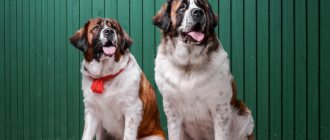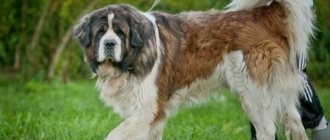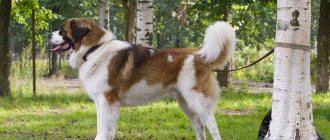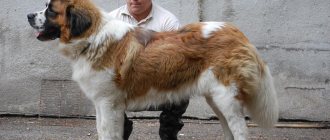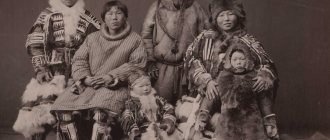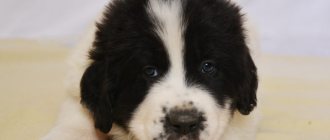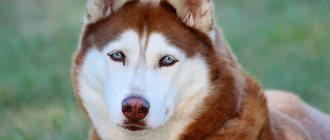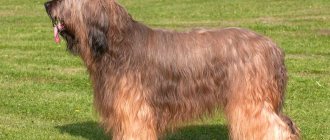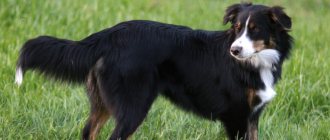Breed characteristics
| Short description | |
| Origin: | USSR (Russia) |
| Conditions of detention: | House with a large garden |
| Purpose: | Security guard dog |
| Color: | Red, white with brown spots, fawn with black mask |
| Wool length: | Average length |
| Adult dog size: | Height of females from 66 cm, males from 68 cm, weight of males from 55 kg, females from 45 kg |
| Average life expectancy: | 10-12 years |
| Walk: | Need active walking twice a day |
| Physical activity needs: | High physical activity needs (regular or daily exercise for more than 3 hours per day) |
| Fédération Cynologique Internationale (FIC) classification: | Group 2: Pinschers and Schnauzers, Molossians, Swiss Cattle Dogs; Section 2: Molossians |
| Puppy price: | From 6,000 to 60,000 rubles. Without pedigree - 6000-10000 rubles, pet class - 15000-30000 rubles, breed class - 40000-46000 rubles, show class - 50000 rubles and above |
History of the origin of the species
This breed is quite young, it appeared in the middle of the last century . The Soviet Union needed strong working dogs, especially after World War II. It was then that the first shortcomings of the cynology of the USSR and the advantage of European countries in the number of service dogs appeared. At this time, the German Shepherd was already popular in the country, but it could not work in the harsh Russian frosts. Therefore, it was decided to breed a new guard, strong, frost-resistant breed.
1949, the Krasnaya Zvezda kennel receives an order to breed a large service dog. The new dog had to incorporate the intelligence, aggressiveness, service qualities of the German Shepherd and the good nature, frost resistance and large St. Bernard.
The standard was published in 1958, in Russia the breed was recognized in 1985. The Moscow Watchdog is still not recognized by world clubs.
Reviews
A few reviews:
“I am a big fan of Caucasian Shepherds and St. Bernards, and when they offered me a small “Muscovite,” I happily agreed. This is an amazing creature, whole, original, somewhat similar to a St. Bernard, but also has a lot of its own. I would recommend the dog only to strong personalities who know how to lead and be in charge.”
“It’s not easy to keep in an apartment. Constant fur that has to be cleaned every day and walks that take four hours a day.”
Distinctive features
The Moscow Watchdog is a large dog with a rough, massive, elongated format. It has a typical mastiff appearance: folds around the neck, thick elastic skin, impressive size.
Dogs have no restrictions on their height; the only limit is not lower than 66 cm. The weight of dogs ranges from 45 to 80 kg. The standard was published again many times, each change did not particularly please breed lovers and enthusiasts. The last changes were made in 2003. All puppies with obvious shortcomings or inconsistencies with the characteristics are discarded:
- The head is wide, massive, deep. The occipital protuberance, frontal bones, feet and brow ridges are visible The frontal sulcus is clearly visible. Rounded cheekbones .
- The muzzle is shorter than the skull, wide and blunt. Full set of teeth (42) and scissor bite Lips fit tightly. They have black pigmented outlines.
- The nose is large, with developed nostrils, and always black.
- The eyes are set wide, deep and straight. The color of the iris is dark.
- The ears are set high (above the eye line), hanging down to the level of the cheekbones. Triangular shape. Quite large and fleshy. The cartilage is wide.
- The body is voluminous, stretched, strong, well built with pronounced withers. The chest is wide and deep (half the height), with rounded ribs. The neck is short, strong, oval in cross-section, with dewlap.
- The limbs are straight and parallel, set wide apart (the hind limbs are slightly wider). The paws are oval with tightly knit, hard toes. The pads are hard, the claws are of any color. Movement : trot or gallop.
- The coat is straight, hard, thick and long. The undercoat is soft and moisture resistant.
- Colors: red or spotted (white with red, black or sable spots). The presence of red color, white spots on the chest and paws is mandatory.
Description of the breed with photos
At first glance, it may seem that the Moscow Watchdog looks like a St. Bernard and even has a lot in common with it. However, in reality, there are quite a lot of differences between breeds. For example, the size of the animal - Moscow watchdogs are somewhat inferior in size to Swiss dogs. In addition, they are distinguished by a narrower skull, elongated body, and strong bones.
Let's consider what the characteristics of the breed are and its external features.
- Head. The Moscow watchdog is distinguished by a head with a convex forehead and pronounced cheekbones. The muzzle is rather short, voluminous and blunt. The brow ridges are clearly expressed, the infraorbital areas are filled.
- The lips are fleshy and deep black. There are no wings (the dog's lips).
- The dogs are characterized by heavy jaws and a scissor bite; 42 large teeth that fit tightly together.
- The nose is elongated and large; our nose is painted black.
- The eyes are small, covered with thick eyelids, and deep-set. Most often painted black.
- Drop ears are located slightly above eye level. They have a triangular shape with slightly rounded tips near the cheekbones.
- The neck is of medium length, muscular and strong; the nape and dewlap are well developed.
- The body of the Moscow guard dog is more elongated compared to St. Bernards; the withers are higher (especially in males). The animal's back is strong, the loin is short, the chest is deep with convex ribs, the croup is slightly sloping. Tightened belly line.
- Dogs of this breed have straight, parallel legs. Long, oblique shoulder blades, thighs and shins of approximately equal length. Heavy paws have a rounded shape.
- The tail is quite thick; it continues the line of the croup and descends downwards in the abdominal area. It forms a slight bend in the tip area.
- The thick coat consists of hard axial hair and abundant undercoat, due to which many animals have a semblance of a thick collar and feathering in the paw area. Males have more abundant hair than females.
Size and weight
The dog's weight ranges from 45–70 kilograms, but larger individuals can also be found. The height is from 60 to 70 centimeters.
Color and coat type
The Moscow guard dog most often has a red-black, black-red or red color. The absence of a red tint in the color is extremely rare and rather atypical. At the same time, the animal’s chest, as well as the tip of the tail and paws, is always white. The head is surrounded by black fur, the ears are the same color.
Photo of an adult dog
Photos of puppies
Features of character and behavior
This breed is a service breed and at the moment it has not lost its service qualities . It is rarely recommended as a companion dog, although it is quite friendly to household members. Such a pet will become a thunderstorm for anyone who tries to cross the threshold of a house or the border of a fence. When enraged, the Moscow Watch is truly dangerous.
This dog is not overly aggressive, quite balanced and calm. But she needs to be seriously educated and trained; she will not obey a weak-willed person. It is not recommended for beginners, elderly people or children.
Advantages
Guard dog, protection dog, service dog. The Moscow Watchdog serves in many cities of Russia, in the border troops and police.
- Their physical qualities make it possible to export dogs to the far north, where they are indispensable both in private households and in security services. Such pets never give up and protect their territory and family at the cost of their lives.
- Watchdogs are loyal and affectionate.
- They treat children well and will not react aggressively to them or offend them. But due to its size and mental abilities, you cannot buy such a pet as a gift for a child.
- Calm and unobtrusive, they bark only when necessary.
- You could say that at home these pets are cute, lazy teddy bears who love to spend time with their family.
Flaws
- This breed is very serious and dangerous without proper training. She needs a firm hand, literally and figuratively.
- Dogs weigh a lot, the fragile girl is physically unable to restrain the power of the dog when he tries to break free from the leash.
- Really unfriendly to outsiders. Any unfamiliar person seems like a threat to the Moscow Watchdog: both a child and an adult. Therefore, such a pet must always be kept on a leash and muzzled when walking in crowded places.
- They do not like other animals, especially dogs. They will attack them at every opportunity.
- They can be stubborn and disobedient. Usually they do not strive to take the position of master in the house, but without competent maintenance they will “sit on the neck.”
Education and training
A guard dog is a test of the owner's coaching and leadership qualities. Even the most balanced and obedient “Muscovites” are not averse to playing alpha males and wiping their paws on their master’s authority. So from the very first days of the young shaggy dog’s stay in your home, establish a system of permissions and strict prohibitions and do not deviate from the set course until the pet matures.
Moscow guard dog training
Typically, Moscow watchdogs begin to show character at 6 months of age. In particular, adolescents may deliberately not respond to calls for food or may grumble and snarl displeasedly in response to the command. In such cases, the method often used by the mothers of puppies themselves will be effective. The disobedient disciplinarian is knocked down, toppled onto his side, and forcibly held in a supine position until he has properly reflected on his own behavior and calmed down.
Never show your older puppy that his massive jaws scare you. Moscow guard dogs are quite perceptive and will quickly understand that they have “outgrown” your authority. Teasing and provoking a dog, trying to develop guarding skills in it, is also not the best technique. If you regularly try to take away a toy or food from an MS, prepare for such negative bonuses as anger and nervousness.
There are also subtleties in using commands. So, for example, the call “Come to me!” not used for cases when the trainer is going to punish the pet. Not a single dog will voluntarily come up to “distribute gingerbread”, let alone a Moscow guard dog. Ban "Ugh!" They pronounce it in a categorical, threatening tone so that the “Muscovite” does not have the desire to test the owner’s patience. Owners who are raising a future exhibitor will find the “Show your teeth!” commands useful. and “Nearby!”
It’s worth considering taking your dog to a ZKS course if you see your pet as a future bodyguard. If the candidacy of a Moscow watchdog is being considered for the place of a family friend or guard, you can limit yourself to home training. True, it should be dealt with by an adult with a strong character, who has an understanding of the psyche and temperament of the breed.
Care and maintenance
From the very beginning, the breed was planned as unpretentious in maintenance. And so it happened. The Moscow Watchdog can get along in any conditions and does not require special care. The only problem is the size of the dog. Because of this, medicines and food become especially expensive. In addition, the pet is not well suited for apartment life; such a dog will feel best in a country house with a large territory. The watchdog can live outside in a booth or enclosure.
Before buying a puppy of this breed, you need to think carefully about the place for the pet. There must be a lot of it. In addition, you need to purchase a comfortable large lounger or mattress, bowls for water and food on stands, hygiene products, brushes, and toys.
- Ears and mucous membranes are examined regularly. But they need to be cleaned and washed as they become dirty.
- It is important to maintain oral hygiene ; chewing ropes for large breeds are a good help. If purulent discharge from the eyes and ears occurs, you should contact a veterinary clinic.
Nutrition
Moscow watchdogs are not picky: they will eat everything their owner gives them. These dogs, despite their large size, do not eat much due to their slow digestion. However, for a dog to fully develop properly, it needs a diet of three components:
- Cereals (cereals, several types of cereals);
- Vegetables and fruits (fresh and boiled in porridges);
- Meat (several types, preferably lean, boiled or raw; approximately 50% of the daily diet).
You should not feed your dog sweets and baked goods; Giving small bones, fatty and spicy foods is prohibited.
Watchdogs can also be fed dry foods. If the owner has chosen this path, then he should buy premium and super-premium food. This is much simpler, but the choice of products must be made more carefully; good food is really expensive. Low quality food is not suitable for this breed and can be detrimental to your pet's health. It is necessary to mix a vitamin complex and supply your pet with calcium for proper bone growth.
When purchasing a puppy from a breeder, you need to find out what the dog ate. A sudden change in food can lead to bloating and stomach upset. You cannot mix natural food and dry food; you should stick to one type of food.
Muscovites have a tendency to gain weight quickly. Therefore, you cannot overfeed them.
- Puppies are typically fed 3-4 times a day.
- Adults – 2 times (in the morning and evening after walks).
- The serving size depends on the activity of the pet.
- If the dog lives on the street, there should be more food, especially in winter.
Health
These dogs are distinguished by good health and good immunity. They easily tolerate the cold, and during the hot season they try to hide in the shade. Problems can only arise if the care and maintenance are improper. Moscow watchdogs have practically no genetic diseases.
One way or another, puppies still need timely vaccination. It is also necessary to periodically examine your pet at a veterinary clinic to monitor its condition. Healthy Moscow watchdogs are active and cheerful.
If you observe negative symptoms: diarrhea, vomiting, yellow whites of the eyes, lack of energy, loss of interest in food, you should immediately contact a veterinary clinic and undergo a course of treatment.
Vaccinations
Puppies of all breeds must be vaccinated after maternal immunity wears off.
- This happens at 1.5-2 months , then you need to get the first vaccination against enteritis, parainfluenza, leptospirosis, mumps, salmonella, hepatitis.
- Vaccination is repeated after 2-3 weeks , then at 6 and 12 months .
- It is important to update your vaccination every year.
- As a rule, the first two procedures are carried out in a kennel, where the dog’s veterinary passport is obtained.
- The second necessary vaccination is against rabies. It is done when the puppy reaches six months of age. It also needs to be updated every year. This vaccination is required to take your pet abroad.
There are several rules for grafting:
- The dog must be absolutely healthy and disinfected from worms (two weeks before); pregnant and lactating bitches are not allowed to undergo vaccination;
- The puppy cannot be walked before the second vaccination;
- After each procedure, it is important to maintain quarantine (14 days);
- All drug labels are pasted into the animal’s passport;
- Vaccinations are done by specialists in veterinary clinics;
- In case of prolonged side effects (malaise, fever, vomiting), you should consult a doctor.
Vaccinations cannot be neglected; unvaccinated animals (especially puppies) are susceptible to diseases that most often lead to death. The cost of the vaccine ranges from 400 to 1000 rubles.
Diseases
Moscow watchdogs are not genetically predisposed to diseases.
- The most common problems are with the musculoskeletal system, namely dysplasia of the hip and elbow joints. It leads to deformation of the limbs, lameness and acute pain. Unfortunately, this disease is incurable, but it is possible to relieve your pet’s suffering with medication or surgery. To avoid problems, you need to monitor your dog’s weight and exercise.
- The second most common disease is obesity. It occurs due to the pet’s low activity and immobility. The diet must be adjusted and balanced, taking into account all physical activity.
- In addition, Moscow watchdogs are prone to allergic reactions to food and hygiene products. Therefore, they need to be selected carefully.
Walk
The Moscow Watchdog is a large dog that is prone to laziness and obesity. Walking them takes at least 2.5 hours a day. When living in an apartment, walks should be twice a day (morning and evening for 1-1.5 hours). The dog should be given active exercises such as running and swimming (in summer). Puppies are walked more often ( 3-4 times a day) for 30-40 minutes.
The hind limbs cannot be loaded . Active jumping will not contribute to strengthening, but will develop dysplasia. Such large dogs should always be kept on a leash to avoid aggressive outbursts towards strangers. Socialization should begin as early as possible so that the puppy gets used to people.
Grooming
These dogs do not need constant haircuts or trimming.
- Hair care comes down to regular brushing with a slicker brush and a furminator.
- As a rule, 3-4 times a week is enough.
- Guards are bathed rarely, a couple of times a year. Street dogs are not washed at all: they are wiped with a hard cloth, snow, or sprayed with a hose.
Best qualities
All watchdogs have similar qualities:
- presence of a cold mind - the animal is capable of quickly falling into a rage, but knows how to pull itself together;
- desire to learn;
- poise - will not attack in the absence of a clear threat;
- territoriality;
- focus on the owner, on a specific person. Many guard dogs for private homes were once engaged in protecting flocks and for a long time communicated exclusively with shepherds;
- endurance;
- presence of sensitive hearing;
- the presence of highly developed intuition;
- ability to make decisions independently;
- cunning.
Some guard dogs do not need any specific training; their main mission is protection. Universal dogs must be aware of the task at hand, that is, the owner will need to place all the emphasis when carrying out basic training.
Man and dog are a duo that arose a long time ago. As living conditions changed, the purpose of dogs in people's lives also changed. Different trends in breeding have emerged, but today, as before, breeds of guard dogs for private homes are especially popular, you can learn more about them in this section.
Mating
Puberty reaches dogs at 8-10 months , but since Moscow watchdogs take quite a long time to mature, the best age for mating a female is 18-20 months , and for a male - 2 years . The third heat is a signal that indicates the girl has fully matured. On days 13-15, symptoms of readiness should appear: a swollen loop, light pink discharge, playful behavior. Most often, dogs lick the genitals, so it is advised to apply cotton wool to the loop to find out about the appearance of bloody lubricant.
Breeding bitches must be registered in nurseries and certificates for mating must be obtained for them. You need to initially select a suitable male and agree on mating in advance. Animals must be checked for the presence of pathologies and diseases, and deworming should also be carried out.
Animals need a lot of free space. The bitch is brought to the dog, where the dogs are given time to sniff and get to know each other ( 10-15 minutes). If everything goes well, the girl will allow you to do the cage. The act will last 5-10 minutes , the lock - 15-20 . At this time, the female should be supported under the belly, not allowing her to sit down. The boys are sent to the noose. An experienced specialist is usually invited to decouple the dog. Mating is repeated after 2 days.
Health
The average life expectancy of Moscow watchdogs is 8–10 years. A relatively short period of time is considered the norm for large breeds, because rapid wear and tear of the heart muscle, organs and joints is a completely predictable phenomenon. Diseases typical for the breed are listed in a fairly short list:
- Hip dysplasia is a “typical” disease for all overweight dogs. With age or due to metabolic insufficiency, the rate of renewal of articular tissues decreases. As a result, the joints (elbow, hip), which bear a large load, suffer from rapid abrasion. In its advanced form, the joint becomes severely deformed, causing the dog pain or making it impossible to walk. In the early stages, therapeutic treatment or surgery is possible to reconstruct the joint. As a rule, even surgery does not guarantee a complete cure.
- Food allergy or seasonal allergy is a purely individual ailment caused by a variety of reasons and giving an unpredictable reaction to the body. Treatment consists of searching for and eliminating the allergen that caused the body’s protective reaction. If we are talking about allergies to flowering herbs, antihistamines are used.
An important issue in a dog's health is its normal physical weight. The Moscow Watchdog, even without “extra fat,” is a large and heavy dog; even 1–2 additional kilograms will have a detrimental effect on all vital systems. Excess weight is dangerous for the breed, but as practice shows, there is still a tendency to the disease. Each owner must understand the degree of risk and feed the Moscow Watch strictly in accordance with its needs.
Key points in training
The Moscow Watchdog is prone to dominance and displaying its character. Obedience can be achieved without harsh methods, showing your superiority. For example, you should not feed your pet until the family has finished eating. Or not allowing the dog to do what he wants. Brute force is no help. This is how you can raise an uncontrollable aggressive dog.
The puppy needs to be accustomed to a daily routine, feeding and walking schedule. In addition, the dog must know its name well and follow basic commands:
- "near";
- "it is forbidden";
- "place";
- "voice";
- "quiet".
Read about how to properly train a dog in the article: “Training a puppy: effective methods from dog handlers, learning commands at home.”
Pros and cons of the breed, application
Some of the most notable advantages of a dog include:
- Devotion.
- Calm character.
- Love for children.
- Unobtrusiveness.
- They can easily get along with other animals in the same territory.
- Developed qualities of a guard dog.
- Good trainability and easy training.
- Developed intelligence.
- The dog can feel comfortable inside the enclosure.
The disadvantages of these dogs are:
- Frequent shedding.
- High food costs.
- It is impossible to keep such dogs in an apartment.
- The desire for dominance.
- Stubbornness.
- Grooming is labor-intensive, and the dog’s health needs careful monitoring.
How to choose a puppy
A Moscow Watchdog puppy can be purchased in the post-Soviet space.
- It is highly not recommended to buy such a serious dog from private individuals. You may end up with an unhealthy, aggressive pet.
- A good breeder will present all the necessary documents, talk about the breed line, show the parents, and give advice on keeping and caring for the pet. It is necessary to ask about all diseases of the breed line, to clarify the presence of problems in the puppies.
- Little guard dogs are furballs, fluffy and playful. They will be active and restless, and should not have deviations from the standard or obvious pathologies. You need to decide on the gender of your future friend, because males are larger, stronger and more stubborn than females, but their protective qualities are better.
The cost of a puppy depends on its class. A pet without a pedigree can be purchased for 6,000-10,000 rubles, but a show class suitable for exhibitions will cost 50,000-60,000 rubles .
Reviews from the owners of the Moscow Watchdog
The Moscow Guard is a high-quality purebred dog that will become an unrivaled guard. However, such a pet is quite serious; it requires a lot of effort to raise an obedient and devoted dog.
5 / 5 ( 1 voice )
